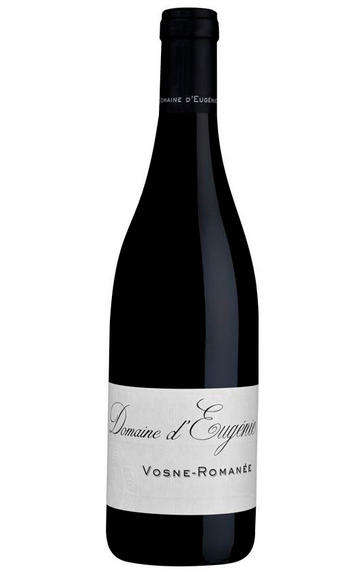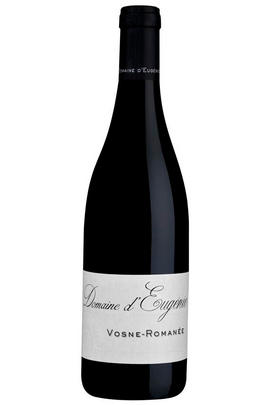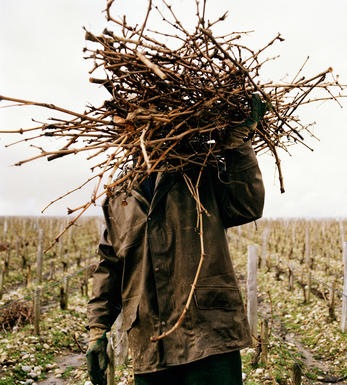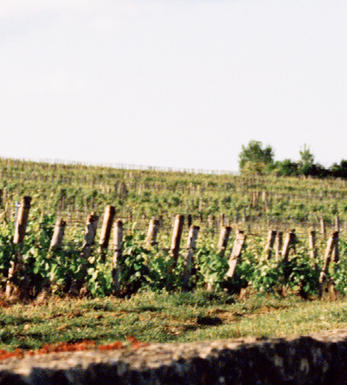
2018 Vosne-Romanée, Domaine d'Eugénie, Burgundy

Critics reviews
The 2018 Vosne-Romanée le Clos d'Eugénie is matured in around 30% new oak this year and includes 50% whole clusters. It has a very attractive bouquet of well-defined cranberry and wild strawberry fruit, and fine mineralité and tension are on display. The palate is medium-bodied with fine-grained tannins, darker fruit vis-à-vis the Vosne Village and a saline, black-pepper-tinged finish. Recommended.
As usual, winemaker Michel Mallard guided me through the latest releases from Domaine d’Eugénie, though this time he was joined by Frédéric Engerer, who heads up the properties under François Pinault’s Artemis Group. "We went twice in the vineyard," Mallard told me. "We did some green harvest in July and then three weeks before picking as there were some vines with 13 and 14 bunches. There were berries that were pink and green, so we eradicated these too. We started the picking on 2 September and finished on 9 September. The maximum alcohol is on Clos Vougeot 13.7%. We continue to use no SO2 during the alcoholic fermentation."
These wines are now beginning to really show that intangible known as "soul" and these 2018s are some of the best that I have encountered from d’Eugénie since it rose from Domaine Engel back in the mid-noughties. Part of the reason is Mallard’s judicious use of whole bunch. There was some discussion between Mallard and Engerer about exactly how much is optimal (of course, it is an alien concept back at Latour) although I opined that I think Mallard got it just right. These 2018s show more character and intellect that those I was tasted a few years ago and are worth seeking out.
Drink 2023 - 2038
Neal Martin, Vinous.com (January 2020)
From a walled plot just beside the winery. Not a registered name; a commercial name. 50% whole bunch. Three of the eight barrels were new. Barrel sample, no added sulphites.
Mid cherry red. The super-refined aroma of dark-red fruit. A touch of stemmy freshness on the nose, slightly herbal. Tight, lithe, dry and full of energy, with a rocky/stone dry quality to the tannins. Extreme. Freshness is in the aromas. Winemaker Michel Mallard says it was very gourmand when first in barrel but that after 12 months it has lost that richness and become much tighter in the mouth. Elegant and tight on the palate. Dry, corseted and elegant. Long too.
Drink 2023 - 2030
Julia Harding MW, JancisRobinson.com (December 2019)
Extremely delicate, but has clear power, intensity and spice that builds up one step at a time, taking you slowly and carefully along with it. First vintage 2009, 50% whole cluster, from a 0.5ha just below La Tache. I love this wine, a brilliant addition to the range that showcases the skill of winemaker Michel Mallard.
Drink 2020 - 2036
Jane Anson, Decanter.com (February 2020)
About this WINE

Domaine d'Eugenie
Domaine d'Eugénie is the reincarnation of the famed Domaine Engel. After the tragic early death of Philippe Engel in May 2005, his family decided to sell the domaine. The highest bidder was François Pinault, owner of Château Latour in Bordeaux, whose right-hand man Frédéric Engerer had long had a passion for burgundy. The 2005 harvest had already been sold off in bulk, but the new team, including young vigneron Michel Mallard from Ladoix, made the 2006, 2007 and 2008 in the Lupé Cholet headquarters in Nuits-St-Georges. From 2009 they have moved into the now refurbished Clos Frantin buildings in Vosne itself.
Yields are significantly lower than in Philippe’s day and the vineyards have been meticulously looked after, including a substantial programme of replacing missing individual vines, which will be picked separately and declassified into the village Vosne in their youth.
The principal decision is whether or not to keep any stems. None were retained in 2006, but an experiment with one of the two fermentation tanks of Clos de Vougeot the following year was positive, the blend of half with and half without stems showing textural qualities and a sense of energy over and above either individual version. The experiment has been continued in 2008 and extended to the Grands Echezeaux.
Otherwise, the grapes are vinified in fairly classical manner, with a preference for punching down rather than pumping over, then matured in barrel for a minimum of 15 months (village Vosne), or rather longer for the grands crus which receive around 80% of new wood.
The first vintage released by the Domaine was in 2006. The highly impressive 2007 vintage is a truly representative vintage for Domaine Eugenie, showing each of the vineyards in its true guise.
Jasper Morris MW, Burgundy Wine Director and author of the award-winning Inside Burgundy comprehensive handbook.

Vosne-Romanée
The small commune of Vosne-Romanée is the Côte de Nuits’ brightest star, producing the finest and most expensive Pinot Noir wines in the world.. Its wines have an extraordinary intensity of fruit which manages to combine power and finesse more magically than in any other part of the Côte d’Or. The best examples balance extraordinary depth and richness with elegance and breeding.
Situated just north of Nuits-St Georges, Vosne-Romanée boasts eight Grand Cru vineyards, three of which include the suffix Romanée, to which the village of Vosne appended its name in 1866. The famous La Romanée vineyard was formerly known as Le Cloux but was renamed in 1651, presumably after the Roman remains found nearby. In 1760 the property was bought by Prince de Conti, and subsequently became known as Romanée-Conti.Vosne is the home of the phenomenally fine wines of Domaine de la Romanée-Conti; divine wines that are, as they say, not for everyone but for those who can afford them. The region also boasts some of the world’s most talented, quality-conscious and pioneering producers: Domaine de la Romanée-Conti of course, but also Henri Jayer, Lalou Bize-Leroy, René Engel, as well as the Grivot and Gros families, to name but a few.
Vosne-Romanée has the greatest concentration of top vineyards in the Côte d’Or, including the tiny Grand Crus of the astonishing La Romanée-Conti (a monopoly of Domaine de la Romanée-Conti producing about 600 cases a year), the classy, complex La Romanée (a monopoly of Vicomte Liger-Belair, but until 2002 bottled under Bouchard Père et Fils, producing a minuscule 300 cases or so a year) and the little-known La Grande Rue. As the name suggests, this runs up the side of the road out of Vosne. Originally a Premier Cru, it was rightly upgraded in 1992, although its rich, spicy, floral Pinots are yet to reach their real potential under Domaine Lamarche who hold it as a monopoly.
By convention the wines of neighbouring Flagey-Echézeaux are considered part of Vosne-Romanée. These include the large, very variable 30-hectare Echézeaux (divided between 84 different growers) and the more consistent, silky, intense, violet-scented Grands Echézeaux Grands Crus.
La Tâche is another monopoly of Domaine de la Romanée-Conti. It is explosively seductive with a peerless finesse, and is almost as good as their legendary eponymous wine. Richebourg is one of Burgundy’s most voluptuous wines and is capable of challenging La Tâche in some years, while Romanée-St Vivant, which takes its name from the monastery of St Vivant built around 900AD in Vergy, has a lovely silky finesse but is slightly less powerful.
If that wasn’t enough, Vosne-Romanée also boasts some absolutely magnificent Premiers Crus headed by Clos des Réas, Les Malconsorts (just south of La Tâche, and arguably of Grand Cru quality) and Les Chaumes on the Nuits-St Georges side, Cros Parantoux (made famous by Henri Jayer), Les Beaux Monts and Les Suchots on the Flagey-Echézeaux border. The old maxim that ‘there are no common wines in Vosne-Romanée’ may not be strictly true, but it is not far off.
Drinking dates vary, but as a general rule of thumb Grand Crus are best drunk from at least 10 to 25 years, while Premier Crus can be enjoyed from 8 to 20 years, and village wines from 5 to 12 years.
There are no white wines produced in Vosne-Romanée.
- 99 hectares of village Vosne-Romanée.
- 56 hectares of Premier Cru vineyards (14 in all). Foremost vineyards include Les Gaudichots, Les Malconsorts, Cros Parentoux, Les Suchots, Les Beauxmonts, En Orveaux and Les Reignots.
- 75 hectares of Grand Cru vineyards: Romanée-Conti, La Romanée, La Tache, Richebourg, Romanée St Vivant, La Grande Rue, Grands Echézeaux, Echézeaux.
- Recommended producers: Domaine de la Romanée Conti, Leroy, Cathiard, Engel, Rouget, Grivot, Liger Belair.

Pinot Noir
Pinot Noir is probably the most frustrating, and at times infuriating, wine grape in the world. However when it is successful, it can produce some of the most sublime wines known to man. This thin-skinned grape which grows in small, tight bunches performs well on well-drained, deepish limestone based subsoils as are found on Burgundy's Côte d'Or.
Pinot Noir is more susceptible than other varieties to over cropping - concentration and varietal character disappear rapidly if yields are excessive and yields as little as 25hl/ha are the norm for some climats of the Côte d`Or.
Because of the thinness of the skins, Pinot Noir wines are lighter in colour, body and tannins. However the best wines have grip, complexity and an intensity of fruit seldom found in wine from other grapes. Young Pinot Noir can smell almost sweet, redolent with freshly crushed raspberries, cherries and redcurrants. When mature, the best wines develop a sensuous, silky mouth feel with the fruit flavours deepening and gamey "sous-bois" nuances emerging.
The best examples are still found in Burgundy, although Pinot Noir`s key role in Champagne should not be forgotten. It is grown throughout the world with notable success in the Carneros and Russian River Valley districts of California, and the Martinborough and Central Otago regions of New Zealand.


Buying options
Add to wishlist
Description
From a walled plot just beside the winery. Not a registered name; a commercial name. 50% whole bunch. Three of the eight barrels were new. Barrel sample, no added sulphites.
Mid cherry red. The super-refined aroma of dark-red fruit. A touch of stemmy freshness on the nose, slightly herbal. Tight, lithe, dry and full of energy, with a rocky/stone dry quality to the tannins. Extreme. Freshness is in the aromas. Winemaker Michel Mallard says it was very gourmand when first in barrel but that after 12 months it has lost that richness and become much tighter in the mouth. Elegant and tight on the palate. Dry, corseted and elegant. Long too.
Drink 2023 - 2030
Julia Harding MW, JancisRobinson.com (December 2019)
wine at a glance
Delivery and quality guarantee